Welcome to the captivating world of hawks in California! From the dramatic coastal cliffs to the sprawling mountain ranges, the Golden State plays host to a diverse array of these majestic birds of prey. With their impressive wingspans and keen hunting skills, species of hawks are a sight to behold as they effortlessly navigate the skies above.
List of Hawks in California
Red-tailed Hawk – A common sight throughout California, the Red-tailed Hawk (Buteo jamaicensis) is known for its broad wings and distinctive red tail. Keep an eye out for them soaring above national parks like Yosemite and Joshua Tree.
Cooper’s Hawk – Cooper’s hawks are medium-sized hawks are often spotted near bird feeders, preying on other birds with precision. Look for them in urban parks and neighborhoods across the state.
Red-shouldered Hawk – Explore areas like Big Sur and the Sacramento River to catch a glimpse of these elegant hawks.
Northern Harriers – These slender hawks are often observed in coastal wetlands such as the Salton Sea and the San Francisco Bay Area.
Sharp-shinned Hawk – Look for female sharp shinned hawks in areas like the Santa Cruz Mountains and the Sierra Nevada.
Swainson’s Hawk – During their migration, Swainson’s Hawks can be seen in large numbers in California. Keep an eye out for them in the Central Valley and along the Pacific Flyway.
Ferruginous Hawks – Found primarily in California’s drier regions, the Ferruginous Hawk preferred habitats include grasslands and deserts, making areas like Carrizo Plain National Monument and Anza-Borrego Desert State Park potential spots.
Rough-legged Hawk – A visitor from the Arctic, the Rough-legged Hawk can be seen in California during the winter months. Keep an eye out for rough legged hawks in the Sacramento-San Joaquin River Delta and the Modoc Plateau.
Northern Goshawk – The Northern Goshawkis a formidable forest-dwelling hawk found in California’s coniferous regions. Look for them in locations like Los Padres National Forest around Mt. Pinos and Frazier Mountain in northern Ventura County, the Sierra Nevada and the Klamath Mountains.
Broad-winged Hawk – While less common in California, the Broad-winged Hawk can occasionally be spotted during its migration. Check out birding hotspots on breeding season like Point Reyes National Seashore for a chance encounter.
Gray Hawks – Rare and localized hawk in California, mainly found in the southeastern part of the state. Look for gray hawks in areas like the Salton Sea and the Colorado River.
Zone tailed Hawks and Common Black Hawks are rare visitors to California.
Where to Spot Hawks in California
Point Reyes National Seashore: Situated along the stunning California coastline, Point Reyes National Seashore is known for its diverse habitats, including coastal cliffs, grasslands, and forests. This unique combination attracts a wide variety of hawks, offering opportunities to observe bird species like the Red-tailed Hawk, Cooper’s Hawk, and the occasional Broad-winged Hawk during migration. Plan a visit to this scenic destination for an unforgettable hawk-watching experience.
Central Valley: California’s Central Valley is a prime location for hawk enthusiasts. This expansive agricultural region provides abundant food sources, attracting hawks of different species. Keep an eye out for Swainson’s Hawks during their migration season, as they gather in large numbers to feed on insects and small rodents. The Northern Harrier is another common sight, gracefully gliding above the valley’s fields. Visit places like the Sacramento National Wildlife Refuge Complex or the San Joaquin River National Wildlife Refuge for remarkable hawk-watching opportunities.
Sierra Nevada Mountains: The majestic Sierra Nevada Mountains offer a scenic backdrop for hawk watching. As you explore the towering peaks and deep canyons, you may spot the Northern Goshawk, known for its affinity for forested areas. These powerful predators are well-suited to the rugged terrain and are often seen patrolling their territories. Keep your binoculars ready while exploring destinations like Yosemite National Park or Sequoia and Kings Canyon National Parks.
Salton Sea: Located in Southern California’s Colorado Desert, the Salton Sea is a unique and important stopover for migrating hawks. Its rich ecosystem attracts a variety of species, including the Gray Hawk and Common Black Hawk. These riparian habitats offer exceptional opportunities to observe these species of hawks in action. Visit the Salton Sea State Recreation Area or the Sonny Bono Salton Sea National Wildlife Refuge for an immersive hawk-watching experience.
Close to California in Oregon hawks can be found in the Klamath Basin National Wildlife Refuge Complex. Journeying on to see hawks in Nevada, it’s best to go to Red Rock Canyon National Conservation Area or for Arizona’s hawks head to Ramsey Canyon Preserve. Here is a complete guide to hawks in the US or for birds of prey in the US click here.
California Hawks Photo Guide
Red-tailed Hawk (Buteo jamaicensis)

The Red-tailed Hawk is a large bird of prey that is commonly found across North America. This species is part of the genus Buteo, which is often referred to as the “true hawks,” and includes more than two dozen species of raptors.
Red-tailed Hawks have a robust size, ranging from 18 to 26 inches in length and sporting a wingspan that can exceed 4 feet. They have a broad, rounded set of wings and a short, wide red tail. This species is most easily recognized by its rich, rust-colored tail, which gives it its common name. However, juvenile hawks might not yet have this distinctive feature.
Their feathers are generally dark brown on their dorsal side (back) with a lighter, often speckled, ventral side (front). The intensity and pattern of their plumage can vary significantly based on their age and geographic location, as there are about 14 recognized subspecies of Red-tailed Hawks.
As for their diet, Red-tailed Hawks are carnivores and have a broad diet that includes rodents, ground rabbits, reptiles, and other birds. They are skilled hunters that typically sit on high perches and use their keen eyesight to spot potential prey. Once they have identified a target, they swoop down to capture it with their powerful talons.
Red-tailed Hawks mate for life and build nests high off the ground, often in tall trees or on cliff edges. Their nests are made of sticks and can be quite large. They typically lay 1-3 eggs per year, which are incubated by both parents.
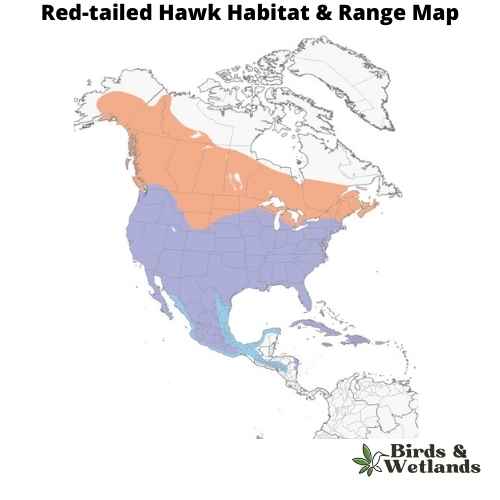
Red-tailed Hawk Sound
Cooper’s Hawk (Accipiter cooperii)

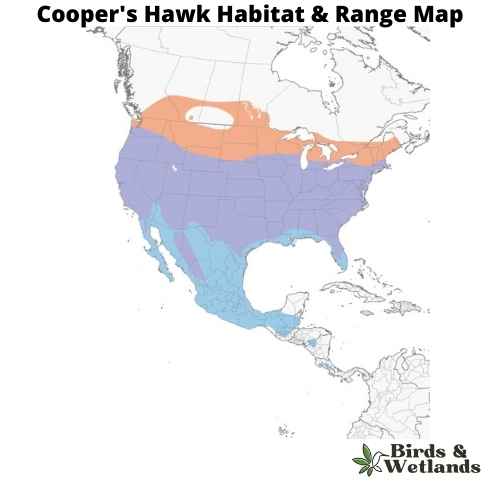
Listen:
The Cooper’s Hawk is a medium-sized bird of prey native to North America. Known for its agility and speed, it is part of the Accipitridae hawk species, which also includes other hawks, eagles, and kites.
Cooper’s Hawks are typically about 14 to 20 inches in length, with a wingspan ranging from 27 to 36 inches. They are known for their distinctive long, rounded tails and short, rounded wings. They have a steely blue gray top, with rusty bars on their underparts and thick, dark bands on their tails.
The Cooper’s Hawk is a skilled predator, primarily hunting birds and small mammals. They are adept at hunting in both dense forests and open areas, often catching prey mid-air in high-speed pursuits. They have also been known to visit the backyard bird feeder, not for the seed, but to prey on the smaller birds that gather there.
Cooper’s Hawks often build nests in dense tree canopies where they are well concealed. The female usually lays 3 to 5 eggs, and both parents share incubation duties. The young hawks fledge after about a month but will stay close to the nest, relying on their parents for food as they learn to hunt.
Red-shouldered Hawk (Buteo lineatus)

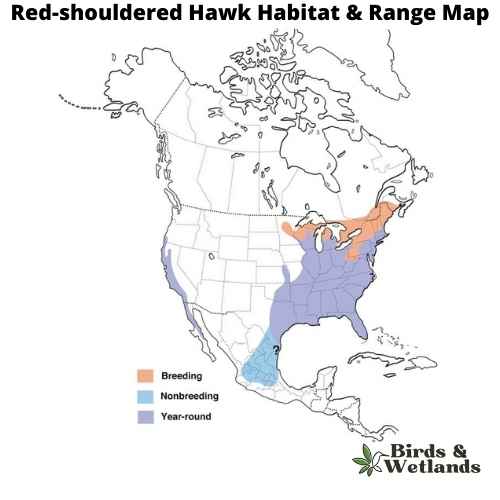
Listen:
The red-shouldered hawk are medium sized birds of prey, part of the buteo hawks family. It can be distinguished from other hawks by its reddish iris and pale legs.
The adult has rusty red upperparts, white underparts, a black chin and throat, and a reddish brown stripe over each eye, reddish brown heads and a strongly banded tail. The tail is reddish brown with two paler bands across it and they have white checkered wings. Juveniles are brown with dark barring and have pale fringes on the feathers of their wings.
Red-shouldered hawks nest in trees, though they also inhabit manmade structures including barns, bridges, and buildings. They prefer wooded areas with an open canopy but will use other places as well for nesting such as shrubs and hedges if needed.
The red-shouldered hawk’s diet – they eat small mammals such as ground squirrels, rabbits, voles, mice and rats. They also eat birds such as quail, pigeons and doves; reptiles including snakes; amphibians; fish; crustaceans; insects; and carrion (dead animals).
Northern Harrier (Circus hudsonius)

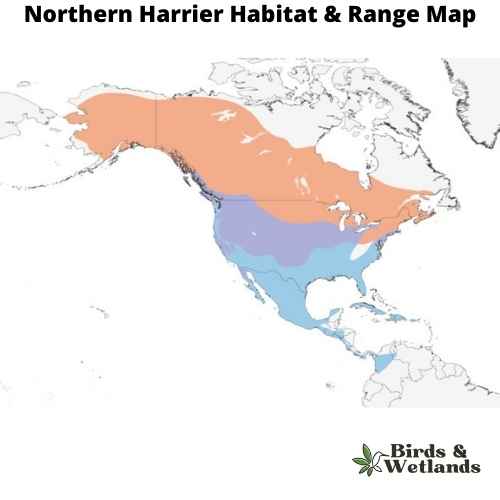
Listen:
The Northern Harrier is a medium-sized, slender hawk.
Adult birds are gray above, with pale bars on the wing feathers and white markings on the underwings and a white rump patch. The breast is barred with black and white, and the belly is streaked with brown.
They prefer open areas, such as grasslands and marshes, but can be found in almost any open habitat except dense woods.
Northern Harriers are opportunistic hunters that feed on small mammals such as mice, voles and rabbits as well as birds including quail, grouse and ducks. They hunt by flying low over open spaces such as fields or marshes.
Northern harrier nests on the ground in lowlands or hillsides near water bodies. It lays two to four eggs which hatch after 24 days of incubation by both parents. The chicks fledge after 30 days of hatching and remain dependent on their parents for another three weeks during which they learn how to fly.
Sharp-shinned Hawk (Accipiter striatus)

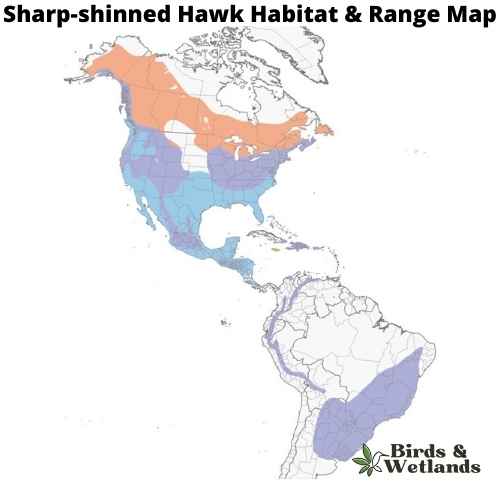
Listen:
The adult bird is brown on top and white underneath, with a dark brown band across its chest. It has short, rounded wings and a long tail that makes it look larger than it actually is. Adult sharp shinned hawks have black eyes, which are surrounded by white feathers. The female Sharp-shinned Hawk is browner than the male, who has darker brown markings on his back.
Sharp-shinned Hawks prefer open country for their habitat, including fields and meadows where they can hunt for mice and other small animals. They can be found throughout the United States but are most common in the east.
Sharp-shinned Hawks eat mostly small birds, such as sparrows and warblers, as well as small mammals such as mice and gophers. They catch prey by surprise using their incredible speed and agility, diving out of the sky at speeds up to 200 mph.
Sharp-shinned Hawks have an unusual hunting style for hawks—they prefer to catch their prey from perches above trees or telephone wires, rather than swooping down from above like most other hawks do and can often be seen hunting near bird feeders.
Swainson’s Hawk (Buteo swainsoni)
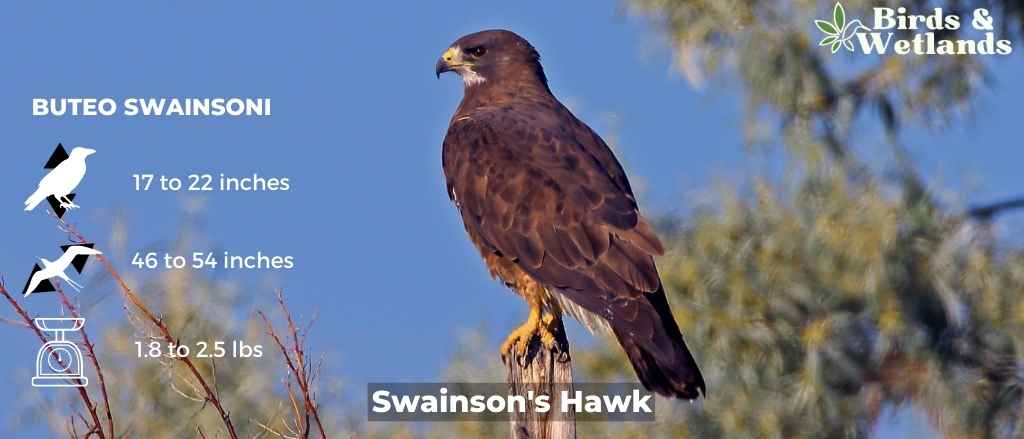
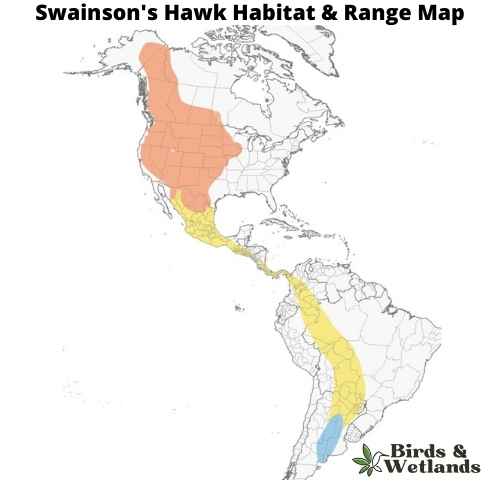
Listen: Swainson’s Hawk
Swainson’s Hawk is a medium-sized hawk that is found in North America and South America, Scientific Name: Buteo swainsoni.
The bird has a blue-gray plumage with a dark brown back, wings, and tail. It also has a white chest and belly. The beak and feet are black, but the eyes are yellow. They are often confused with Cooper’s Hawk because of similar coloring, but Swainson’s Hawks have wider tails and longer wings than their cousin species.
These birds eat small rodents such as gophers and mice. They also eat insects like grasshoppers and crickets during the summer months when they’re plentiful. They sometimes steal prey from other birds of prey such as Northern Harriers who hunt the same prey.
Swainson’s Hawks build nests on rocky cliffs near water sources where they can find food easily. They lay three to five eggs that hatch after about two months into fluffy brown baby hawks who leave the nest after about three weeks (or when they’re big enough).
Ferruginous Hawk (Buteo regalis)

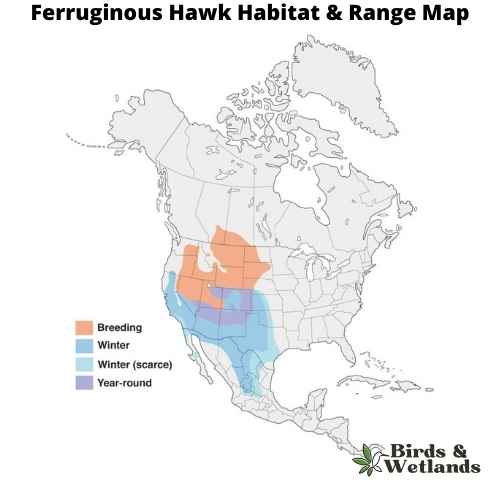
Ferruginous Hawk Sound
Scientific Name: Buteo regalis
Length: 20 to 27 in
Wingspan: 48 to 60 in
Weight: 32.0 to 80.0 oz
The Ferruginous Hawkis the largest hawk species native to North America. Known for its distinctive coloration and impressive size, this bird of prey predominantly inhabits the open landscapes of the western United States and parts of Canada.
Ferruginous Hawks are notable for their “ferruginous” or rust-colored back and shoulders, which contrasts sharply with the bird’s white underside. The hawk also has broad, rounded wings and a large, gape-mouthed beak. Ferruginous hawks exhibit dark morph and light morphs. Dark morphs have dark brown plumage, while light morphs display lighter, reddish-brown plumage. Morphs vary geographically.
Primarily feeding on small to medium sized mammals like rabbits and prairie dogs, the Ferruginous Hawk is an agile hunter, often seen soaring high above the ground or perched prominently while scanning for prey. It occasionally feeds on birds, reptiles, and insects as well.
Nesting for Ferruginous Hawks typically occurs on cliffs, hillsides, or large trees. The female lays between 2 to 5 eggs, and both parents share in the incubation and rearing of the chicks. The Ferruginous Hawk is a relatively solitary bird outside of the breeding season, and its call is a loud, high-pitched scream, often heard during courtship or near the nest.
Rough-legged Hawk (Buteo lagopus)

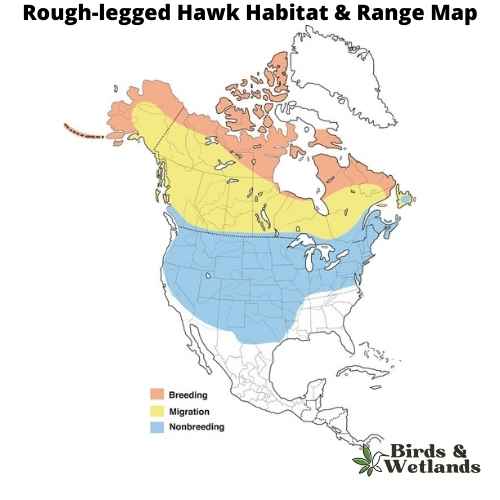
Rough-legged Hawk Sound
The Rough-legged Hawk is a large, raptor that is native to North America. It is also known as the American Rough-legged Hawk. Scientific Name: Buteo lagopus
The Rough-legged Hawk is a medium-sized hawk with a distinctive appearance, with dark brown feathers on its back and light brown feathers on its underside and broad thin wings. The hawk’s legs are also covered in dark feathers, which help to distinguish it from other species of hawk. The tail is barred with black and white. They have yellow eyes and dark feet.
Rough-legged Hawks hunt from above ground level, swooping down to catch its prey in its talons. When hunting for food, they prefer to eat small mammals such as squirrels and rabbits but will also eat birds if there aren’t any small mammals available. Although they eat a variety of small animals including birds, rodents, bats and reptiles, they rely heavily on fish for food during breeding season because it provides them with protein and calcium needed to produce eggs.
Northern Goshawk (Accipiter gentilis)


Listen:
The Northern Goshawk is a medium-sized hawk that is found in North America, Europe and Asia. It has brown eyes, a large sharp beak, and dark brown plumage on its upperparts and head, with white underparts that are spotted with brown barring. Its tail feathers are grayish-black with a dark band near the tip.
Northern goshawks eat squirrels, rabbits, grouse, woodchucks and other small mammals like voles or mice (which they often eat whole). They will also take larger prey such as deer fawns or even adult deer if they have no other choice. They have broad wings with long feathers that allow them to glide through the air when they catch their prey. They also have an excellent sense of smell which helps them locate their food source.
The Northern Goshawk builds its nest in a tree cavity or on a ledge, usually on the edge of an open area so it can easily see prey below. The female lays 3 to 5 eggs over two days and incubates them for 28 to 30 days while the male brings food to her every few hours until they hatch. The young fledge after about 6 weeks and leave the nest when they are about 10 weeks old.
Broad-winged Hawk (Buteo platypterus)

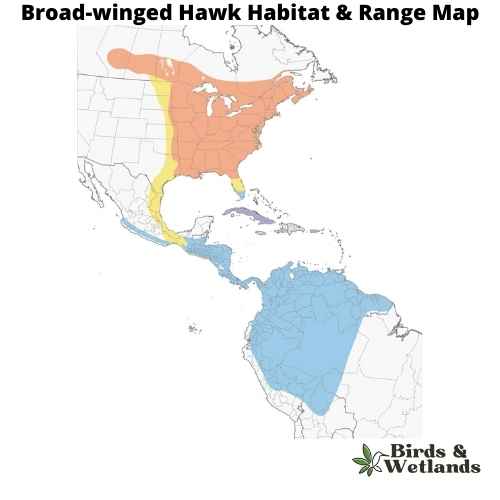
Broad-winged Hawk Sound
The Broad-winged Hawk holds a commanding presence as one of the largest hawks in the world, known for its broad wings. Its formidable size is a testament to its prowess as a bird of prey, effortlessly navigating the open skies in search of food.
Their distinctive appearance sets them apart. The adults exhibit a striking black and white pattern, complemented by a rusty breast and buff underparts and brown wings. In contrast, juveniles are adorned with a brown plumage, marked by pale edges on their feathers, adding to their distinctive youthful charm.
These hawks are most commonly found in open areas, such as farmlands or grasslands interspersed with scattered trees, which provide optimal conditions for when hawks hunt.
When it comes to their diet, Broad-winged Hawks feed on small rodents like mice, rats, squirrels, rabbits, and voles. Broad winged hawks breed during the spring and summer months then migrate to central and south America.
Zone-tailed Hawk (Buteo albonotatus)
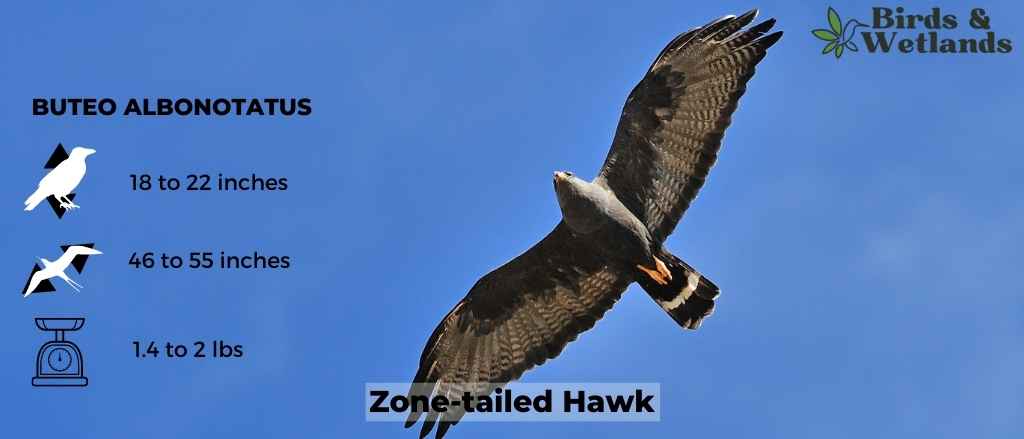

Zone-tailed Hawk Sound
Scientific Name: Buteo albonotatus
Length: 18 to 22 in
Wingspan: 46 to 55 in
Weight: 1.2 to 2 lb
The Zone-tailed Hawk, or Buteo albonotatus, is a medium-sized bird of prey known for its unique appearance and behavior that mimics turkey vultures, a strategy used to deceive prey. This raptor is primarily found in the warmer regions of the Americas, including the southwestern United States, Mexico, and down to Argentina.
The Zone-tailed Hawks body are predominantly black, with white bands, or “zones,” on the tail, which give the bird its name. From a distance, the Zone-tailed Hawk can easily be mistaken for a turkey vulture due to its similar coloration and flight pattern.
Zone-tailed Hawk feeds on small mammals, birds, and reptiles. Its hunting strategy is particularly clever. By mimicking the less-threatening turkey vulture in flight, it can often approach prey unnoticed before launching a surprise attack.
Nesting typically takes place in trees, cliffs, or even on man-made structures. The female lays 1 to 3 eggs, and both parents share incubation and feeding duties.
Gray Hawk (Buteo plagiatus)

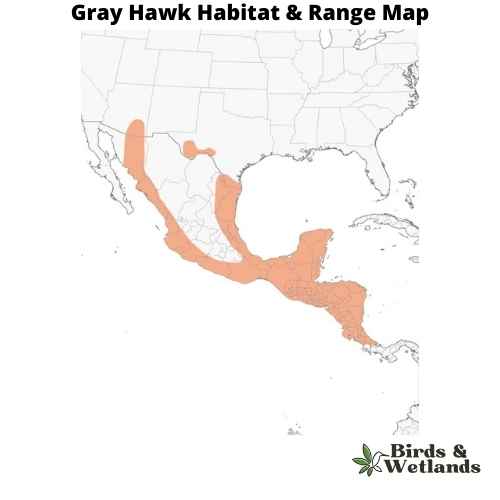
Gray Hawk Sound
Scientific Name: Buteo plagiatus
Length: 18–24 in
Wingspan: 82-98 cm
Weight: 16.8 oz
The Gray Hawk is a small bird of prey native to the Americas. Known for its distinct coloration and elegant flight, this raptor is found in both the southwestern United States and across Central and South America.
Gray Hawks plumage is characterized by a light gray body, contrasted with a darker gray back and wings. Its tail features broad white and gray bands, making it a distinctive feature.
Primarily hunting from a perch, the Gray Hawk feeds mainly on small mammals, birds, and reptiles, including lizards and snakes. It often patrols the edges of clearings, diving swiftly to catch prey off guard.
Nesting for the Gray Hawk typically occurs in trees. The female usually lays 1 to 3 eggs, and both parents share in incubation duties. The nestlings are generally dependent on the parents for food for a few weeks after hatching.
The Gray Hawk’s call is a high-pitched, plaintive scream, which is often repeated several times. The species is primarily a solitary bird, usually seen alone or in pairs.
Common Black Hawk (Buteogallus anthracinus)
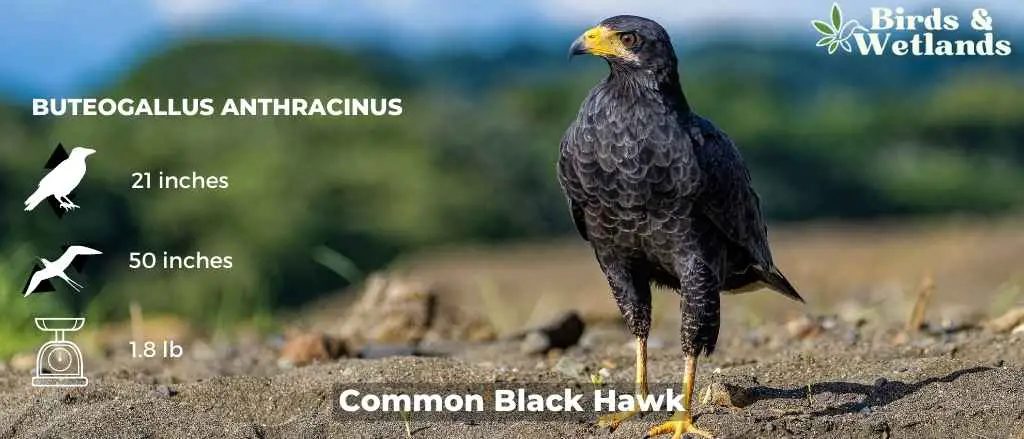
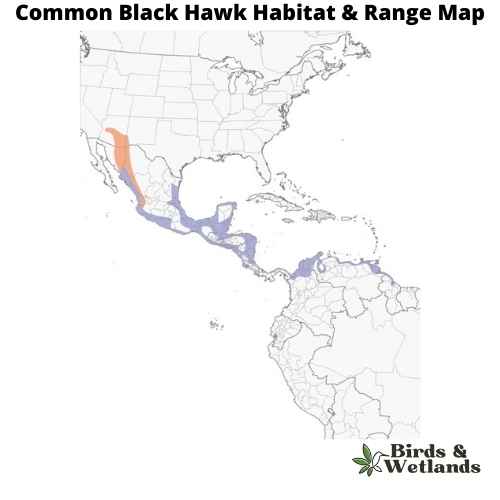
Common Black Hawk Sound
Scientific Name: Buteogallus anthracinus
Length: 21 in
Wingspan: 50 in
Weight: 840g
The black hawk has dark brown feathers on its back and chest, with white feathers on its belly and under its tail. The back feathers have white spots and bars that give it an overall speckled appearance. Its eyes are yellowish-brown, and its legs are long and pinkish-white in color with black talons at the end.
Common Black Hawks tend to live in open spaces near water sources like lakes or rivers because they need water for bathing and drinking as well as hunting prey animals that may be found near such areas.
Common Black Hawks prefer to hunt for small mammals like rabbits, squirrels, and rats. They also eat reptiles like snakes and lizards if they can find them.

